MARKET OVERVIEW
The global water-resistant wall panels market is a niche area in the construction materials sector aimed at meeting the increasing demand for surfaces with both structural integrity and visual appeal when exposed to water. The market is not merely there to provide material that will work within water or high-humidity conditions but also one that will provide solutions in anticipation of the durability issues within contemporary architecture and construction. Waterproof wall panels will increasingly be used as a protection from rot, warping, and mildew problems that conventional building materials frequently cannot withstand.
In contrast to conventional construction panels, water-resistant types have unique production processes intended to support stronger moisture protection. These involve polymer treatments, composite layering, and advanced bonding methods that facilitate extended useful life through various climates and project categories. With urban encroachment bringing structures into formerly uninhabitable or weather-prone areas, developers will increasingly rely on the foregoing materials to support both cost-effectiveness and lower maintenance.
The global water-resistant wall panels market will go beyond basic residential or aesthetic application. Hospitals, laboratories, schools, and industrial buildings each with unique regulatory and performance specifications will incorporate water-resistant wall systems to satisfy environmental conditions and sanitation requirements. In these situations, such panels are not just construction products but working parts of operational safety and regulation. The products offered in this space will become more engineered and targeted, shifting away from one-size-fits-all solutions toward tailored specifications that match project-specific technical demands.
Architectural styles will also continue to influence this market's development. Engineers and designers increasingly prefer clean-surfaced materials and modular building components. As a result, manufacturers will create panels that not only function with moisture but also address both aesthetic and structural requirements. Digital fabrication, CNC routing, and custom finishing will enable the production of panels that are functional and aesthetically compatible with modern design values.
The worldwide supply dynamics will also shape the future direction of the global water-resistant wall panels market. As some areas become increasingly hit by flooding and changes in humidity from climate fluctuations, centers of demand will shift and suppliers will align distribution strategy accordingly. Manufacturing hubs will tend to relocate closer to high-demand areas, mitigating logistics issues and providing localized product offerings that take into account cultural and environmental nuance.
Regulatory compliance will also be a driving force. Certifications for fire ratings, antimicrobial values, and sustainable sourcing will drive the buying decisions in both public and private sectors. These criteria will not be fixed but develop with the changing building codes and global standards, and the industry will be driven to innovate constantly along the material development pipeline.
The global water-resistant wall panels market, though currently niche, will develop into a core aspect of resilient construction practices. Its growth will be fueled not by volume of demand, but by improving precision in use, expanding customization in product formulation, and rising performance requirements across industries. As infrastructures globally adjust to accommodate environmental, regulatory, and functional demands, this market will provide not only material, but long-term dependability for the built environment.
Global water-resistant wall panels market is estimated to reach $2,428.45 Million by 2032; growing at a CAGR of 8.3% from 2025 to 2032.
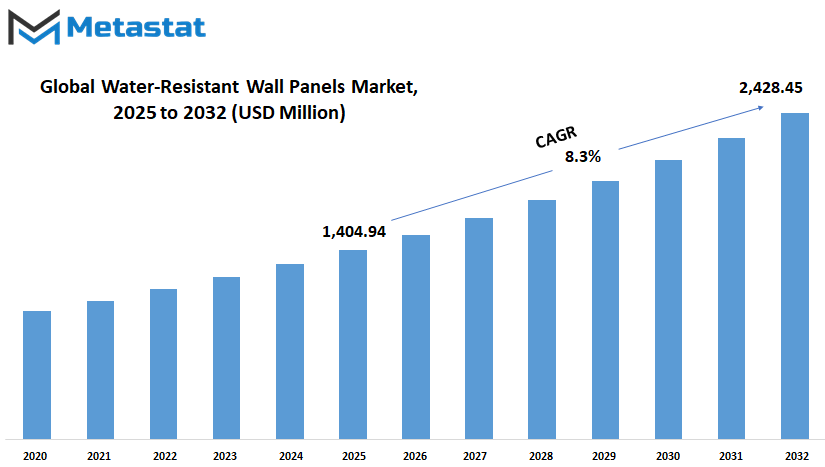
GROWTH FACTORS
The global water-resistant wall panels market is expected to experience steady progress in the coming years due to several important factors. One of the key drivers behind this growth is the increasing need for moisture-resistant materials in both residential and commercial construction. As buildings become more complex and user expectations rise, there's a stronger focus on durability and long-term performance. Spaces that are exposed to frequent moisture like kitchens, bathrooms, basements, and utility areas require surfaces that can withstand damp environments without degrading. Traditional materials like drywall or paint finishes often fail to perform in such conditions, which pushes builders and homeowners toward water-resistant alternatives.
At the same time, the trend of renovation and remodeling has gained momentum globally. More homeowners are investing in updating their existing spaces, especially in areas where water damage is a frequent concern. Older properties are being upgraded not only for aesthetic purposes but also to improve their resistance to water and humidity. This rise in renovation activities is expected to further boost the demand for water-resistant wall panels, especially in regions prone to heavy rainfall or high humidity. These panels are also becoming more popular in commercial settings, such as restaurants, healthcare centers, and schools, where hygiene and cleanliness are critical and water exposure is common.
However, there are challenges that might limit the pace of adoption. The higher upfront cost of water-resistant wall panels, when compared to traditional wall finishes, can deter budget-conscious projects. For small-scale or low-cost housing developments, affordability often takes priority, making traditional solutions more appealing. In addition, some types of panels still face limitations in terms of design flexibility and how well they work with other materials. This lack of versatility can make it hard for architects and designers to fully integrate them into their plans, especially when aiming for unique or high-end interiors.
Looking ahead, innovation will play a major role in shaping the future of this market. Manufacturers that focus on developing eco-friendly and customizable panels will likely tap into the growing interest in sustainable building practices. As environmental concerns become more pressing, green buildings are no longer just a trend they are becoming a standard. Water-resistant wall panels that offer both performance and sustainability will be better positioned to meet future demands. By blending durability with environmental responsibility and design adaptability, the global water-resistant wall panels market can unlock new opportunities and reach broader audiences in the years ahead.
MARKET SEGMENTATION
By Material Type
The global water-resistant wall panels market is steadily gaining attention due to growing demand for long-lasting, easy-to-maintain building materials. With changes in climate and the need for more sustainable construction, these panels are being chosen for both residential and commercial projects. Over time, builders, designers, and property owners have come to value products that can handle moisture without damage. This is especially important in spaces like bathrooms, kitchens, hospitals, and industrial facilities where walls are exposed to water or humidity on a regular basis. Looking ahead, the market is expected to shift further toward durable and eco-friendly solutions.
By material type, the global water-resistant wall panels market includes several options, each with its own benefits and applications. UPVC, or Unplasticized Polyvinyl Chloride, is popular for its strength, resistance to moisture, and low maintenance. It doesn’t swell or warp when wet and remains stable over time, which makes it a preferred choice for interior cladding. Fiberglass Reinforced Plastic, or FRP, is another type that’s already widely used in healthcare and food processing areas due to its resistance to mold and chemicals. As awareness around hygiene and clean surfaces continues to grow, FRP will likely see even more use in future construction projects.
Acrylic Composite Panels, including Wood Plastic Composite, are being selected for their mix of visual appeal and water resistance. These panels give a more natural finish while still standing up to moisture. As technology improves, it’s expected that these panels will become more adaptable to different design needs, combining looks and function. Then there are Metal Panels, like those made from aluminum and stainless steel. Known for their strength and long life, metal panels are often chosen for industrial or commercial buildings. Their ability to resist rust and their smooth, easy-to-clean surfaces make them suitable for harsh environments. In the coming years, advances in coating and manufacturing could make metal panels more lightweight and cost-effective.
The global water-resistant wall panels market will likely keep growing as people move toward better and more dependable construction materials. With changing weather, stricter building standards, and increased focus on health and safety, these panels are becoming more essential. As new materials are developed and improved, the choices will expand, giving more flexibility and benefits to users across various sectors.
By End-User Application
The global water-resistant wall panels market is expected to experience steady growth as more people and industries look for practical, long-lasting, and visually appealing solutions in interior design. Water-resistant wall panels offer protection from moisture and damage, which makes them a smart choice in spaces where humidity and water contact are constant concerns. As awareness around mold prevention, hygiene, and low-maintenance construction increases, these panels will likely become a regular part of modern design strategies. Their ease of installation and long-term cost-effectiveness also make them attractive in both new projects and renovations.
By end-user application, the global water-resistant wall panels market serves several key sectors. Residential bathroom remain one of the most common uses for water-resistant panels. Homeowners prefer solutions that offer both durability and style, especially for wet areas like showers and tubs. These panels reduce the risk of water damage and are easy to clean, which is ideal for busy households. Commercial showers and restrooms also benefit from these features. In places with heavy foot traffic, such as office buildings or public facilities, maintenance costs and repair needs can go down when durable materials are used from the start.
Hospitals and healthcare facilities require surfaces that can handle constant cleaning without degrading. Water-resistant wall panels fit this need while also contributing to a more sanitary environment. The same goes for hotels and hospitality settings, where guest experience and aesthetics play a large role. Panels that resist moisture and wear help these businesses maintain a fresh and inviting look while cutting down on upkeep.
Fitness centers and spas are another fast-growing area. These spaces demand materials that hold up under heavy use and exposure to water and steam. Water-resistant panels can extend the life of walls in these environments, all while keeping them visually appealing. In everyday households and commercial spaces, people are starting to value materials that are both practical and good-looking. This shift in preference could lead to more widespread use of these panels outside of traditional wet areas.
Looking forward, advancements in material technology may further improve the quality and versatility of water-resistant wall panels. Future designs might combine better sustainability with improved resistance to damage and fading. With more sectors looking for dependable materials, the global water-resistant wall panels market will likely continue to grow, shaped by both innovation and the real-world needs of modern buildings.
|
Forecast Period |
2025-2032 |
|
Market Size in 2025 |
$1,404.94 million |
|
Market Size by 2032 |
$2,428.45 Million |
|
Growth Rate from 2025 to 2032 |
8.3% |
|
Base Year |
2024 |
|
Regions Covered |
North America, Europe, Asia-Pacific Green, South America, Middle East & Africa |
REGIONAL ANALYSIS
The global water-resistant wall panels market shows strong potential for steady growth across different regions, with each area contributing in unique ways to the overall market landscape. North America, which includes the United States, Canada, and Mexico, has been showing promising developments, especially with rising construction and remodeling activities. The demand for materials that can last longer and handle moisture well is rising, especially in urban housing and commercial buildings. The U.S. plays a key role here, where advancements in building technology and an increasing focus on sustainable construction are pushing the use of these panels.
In Europe, the water-resistant wall panels market is growing steadily as well, driven by countries like Germany, France, Italy, and the UK. European consumers and businesses are showing more interest in building materials that not only offer long-term performance but also align with environmental guidelines. There's a stronger push toward materials that are easy to maintain and meet safety standards. The rising trend of renovating older buildings using modern materials like water-resistant panels also plays a part in this regional demand.
Asia-Pacific, which includes fast-growing economies like China, India, Japan, and South Korea, is expected to become one of the most important regions in the future. The growing population, rapid urban development, and increasing investment in infrastructure are likely to drive the demand for durable wall panels. Builders in these countries are turning to water-resistant options to improve the quality and lifespan of residential and commercial properties. Governments are also showing more support for modern building solutions, which adds another layer of growth for the market.
South America, particularly Brazil and Argentina, is seeing growing interest in water-resistant panels due to their usefulness in areas with high humidity. There is also increasing awareness about better quality materials that require less maintenance over time. In the Middle East & Africa, countries like Egypt, South Africa, and the GCC nations are beginning to adopt more modern building materials, especially as construction projects expand in both urban and semi-urban areas.
Looking ahead, all these regions are expected to play a part in shaping the direction of the global water-resistant wall panels market. As building needs continue to shift toward durability and low maintenance, these panels are likely to be in higher demand worldwide, supported by technological growth and changing construction trends.
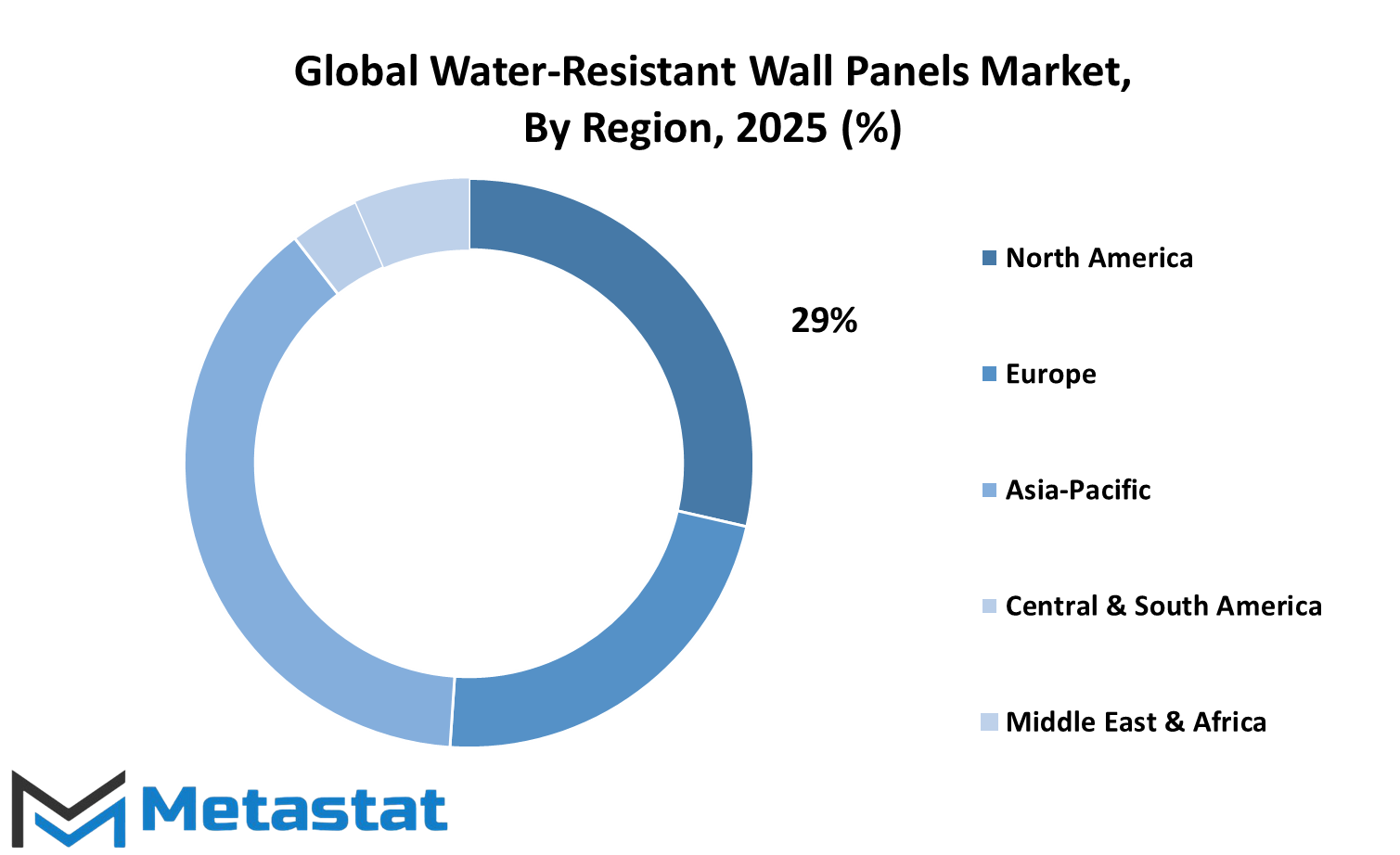
COMPETITIVE PLAYERS
The global water-resistant wall panels market is set to undergo significant transformation as construction trends, consumer preferences, and material innovations continue to shape the future of interior and exterior design. These panels have become a popular choice across residential, commercial, and industrial spaces because they offer a practical, durable, and visually appealing solution for managing moisture. Looking ahead, demand will likely rise even further as cities expand, renovations grow more sustainable, and climate-related challenges push for better building materials. With heightened awareness about mold prevention and energy efficiency, water-resistant panels are becoming more than just a preference they are becoming a necessity.
In the coming years, the global water-resistant wall panels market will see a major shift driven by advancements in design, affordability, and production methods. Manufacturers are expected to introduce new solutions that are lighter, stronger, and easier to install. These improvements will appeal to both homeowners and contractors seeking low-maintenance and long-lasting options. At the same time, eco-friendly choices will grow in popularity as more companies aim to reduce their environmental impact. As recyclable and non-toxic materials gain traction, the market will likely welcome newer entrants alongside the established names.
Competitive players will continue to play a key role in shaping the global water-resistant wall panels market. Companies like Allied Group (Italy), Bath Fitter, and Bhandari Marble Group have already built strong reputations. Others, such as BoDo Plastics, Boniplas, and Citadel LLC, are expanding their portfolios to meet changing customer expectations. Manufacturers like Dumaplast NV and Duramax are investing in research and technology to offer panels that perform better in extreme environments. Fibo, Fushiyuan, and GS Global Impex are focused on balancing cost and quality, which will appeal to buyers looking for dependable yet affordable products.
Inpro Corporation, KOHLER, and LIDA PLASTIC INDUSTRY are expected to focus more on customization, offering styles that match current interior trends without compromising performance. Newer brands such as FundeMAAX and RYAN PVC PANELS are also gaining attention for their flexible solutions. Meanwhile, names like Showerwall, Swan, Texture Plus, and The Onyx Collection are working on product lines that cater to specific regional needs and climate conditions. Brands like Vox Kerradeco, Wet Wall Works, Wickes, and Wilsonart will likely stay competitive by expanding distribution and enhancing customer support.
As construction needs change and customers seek more efficient spaces, the global water-resistant wall panels market will keep growing shaped by innovation, competition, and a push for smarter, cleaner living environments.
Water-Resistant Wall Panels Market Key Segments:
By Material Type
- UPVC (Unplasticized Polyvinyl Chloride)
- Fiberglass Reinforced Plastic (FRP)
- Acrylic Composite Panels (e.g., Wood Plastic Composite)
- Metal Panels (e.g., Aluminum, Stainless Steel)
By End-User Application
- Residential Bathrooms
- Commercial Showers and Restrooms
- Hospital and Healthcare Facilities
- Hotels and Hospitality Settings
- Fitness Centers and Spas
- Household
- Commercial
- Others
Key Global Water-Resistant Wall Panels Industry Players
- Allied Group (Italy)
- Bath Fitter
- Bhandari Marble Group
- BoDo Plastics
- Boniplas
- Citadel LLC
- DECOINN
- Dumaplast NV
- Duramax
- Extrutech Plastics
- Fibo
- Fushiyuan
- GS Global Impex
- Inpro Corporation
- KOHLER
- LIDA PLASTIC INDUSTRY
- FundeMAAX
- Multipanel
- RYAN PVC PANELS
- Showerwall
- Swan
- Texture Plus
- The Onyx Collection
- Vox Kerradeco
- Wet Wall Works
- Wickes
- Wilsonart
WHAT REPORT PROVIDES
- Full in-depth analysis of the parent Industry
- Important changes in market and its dynamics
- Segmentation details of the market
- Former, on-going, and projected market analysis in terms of volume and value
- Assessment of niche industry developments
- Market share analysis
- Key strategies of major players
- Emerging segments and regional growth potential



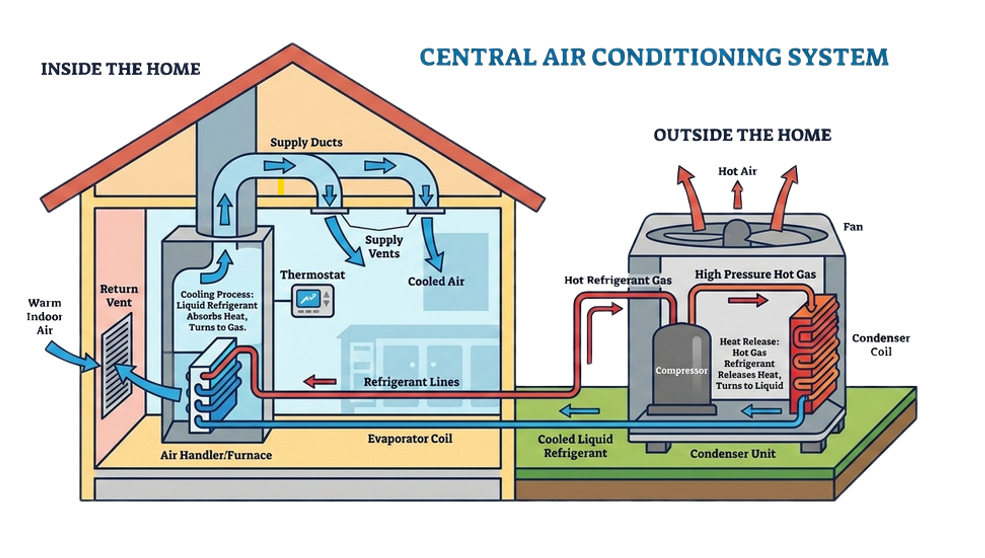
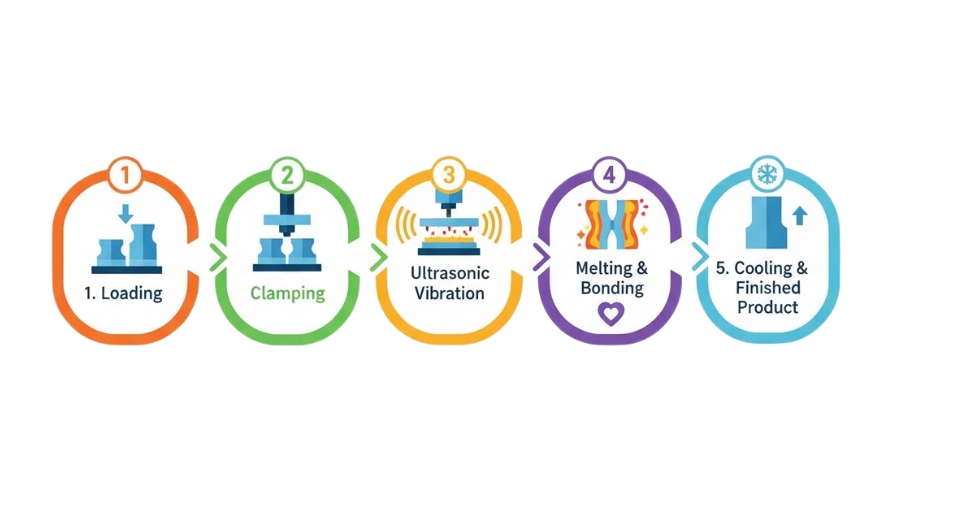
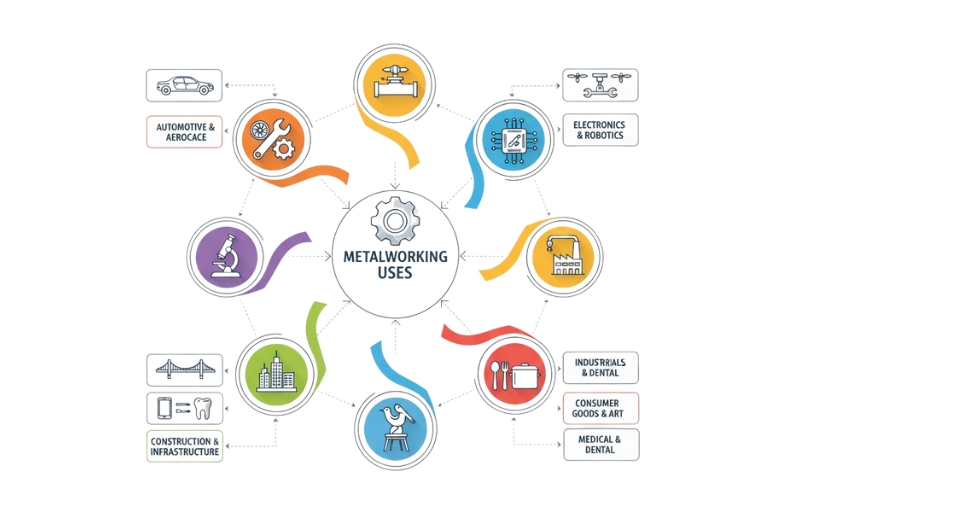
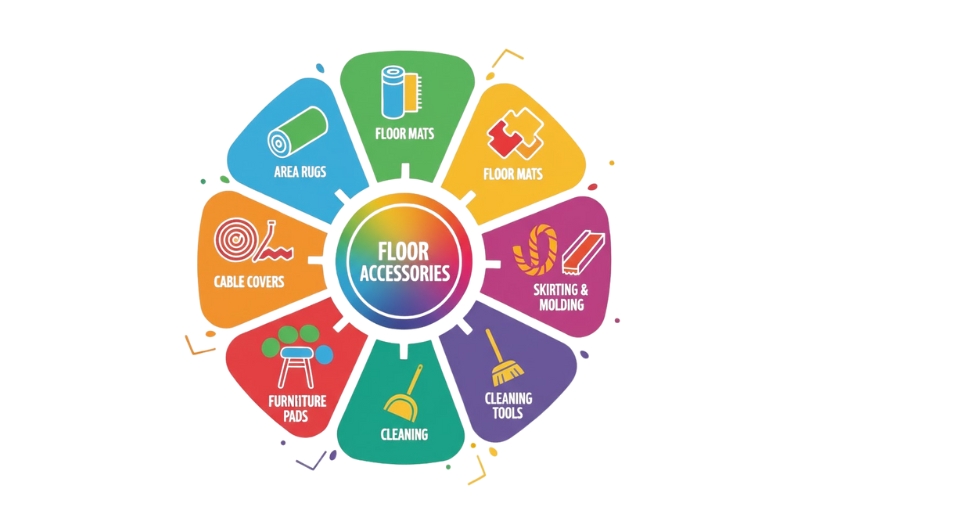

 US: +1 3023308252
US: +1 3023308252






